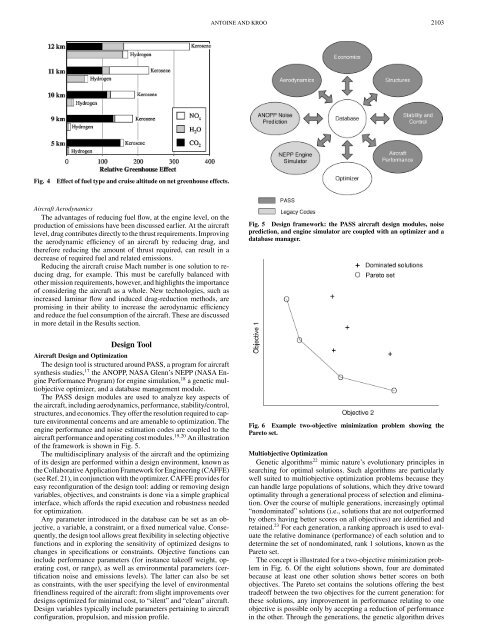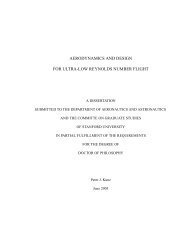Framework for Aircraft Conceptual Design and Environmental ...
Framework for Aircraft Conceptual Design and Environmental ...
Framework for Aircraft Conceptual Design and Environmental ...
Create successful ePaper yourself
Turn your PDF publications into a flip-book with our unique Google optimized e-Paper software.
Fig. 4 Effect of fuel type <strong>and</strong> cruise altitude on net greenhouse effects.<br />
<strong>Aircraft</strong> Aerodynamics<br />
The advantages of reducing fuel flow, at the engine level, on the<br />
production of emissions have been discussed earlier. At the aircraft<br />
level, drag contributes directly to the thrust requirements. Improving<br />
the aerodynamic efficiency of an aircraft by reducing drag, <strong>and</strong><br />
there<strong>for</strong>e reducing the amount of thrust required, can result in a<br />
decrease of required fuel <strong>and</strong> related emissions.<br />
Reducing the aircraft cruise Mach number is one solution to reducing<br />
drag, <strong>for</strong> example. This must be carefully balanced with<br />
other mission requirements, however, <strong>and</strong> highlights the importance<br />
of considering the aircraft as a whole. New technologies, such as<br />
increased laminar flow <strong>and</strong> induced drag-reduction methods, are<br />
promising in their ability to increase the aerodynamic efficiency<br />
<strong>and</strong> reduce the fuel consumption of the aircraft. These are discussed<br />
in more detail in the Results section.<br />
<strong>Design</strong> Tool<br />
<strong>Aircraft</strong> <strong>Design</strong> <strong>and</strong> Optimization<br />
The design tool is structured around PASS, a program <strong>for</strong> aircraft<br />
synthesis studies, 17 the ANOPP, NASA Glenn’s NEPP (NASA Engine<br />
Per<strong>for</strong>mance Program) <strong>for</strong> engine simulation, 18 a genetic multiobjective<br />
optimizer, <strong>and</strong> a database management module.<br />
The PASS design modules are used to analyze key aspects of<br />
the aircraft, including aerodynamics, per<strong>for</strong>mance, stability/control,<br />
structures, <strong>and</strong> economics. They offer the resolution required to capture<br />
environmental concerns <strong>and</strong> are amenable to optimization. The<br />
engine per<strong>for</strong>mance <strong>and</strong> noise estimation codes are coupled to the<br />
aircraft per<strong>for</strong>mance <strong>and</strong> operating cost modules. 19,20 An illustration<br />
of the framework is shown in Fig. 5.<br />
The multidisciplinary analysis of the aircraft <strong>and</strong> the optimizing<br />
of its design are per<strong>for</strong>med within a design environment, known as<br />
the Collaborative Application <strong>Framework</strong> <strong>for</strong> Engineering (CAFFE)<br />
(see Ref. 21), in conjunction with the optimizer. CAFFE provides <strong>for</strong><br />
easy reconfiguration of the design tool: adding or removing design<br />
variables, objectives, <strong>and</strong> constraints is done via a simple graphical<br />
interface, which af<strong>for</strong>ds the rapid execution <strong>and</strong> robustness needed<br />
<strong>for</strong> optimization.<br />
Any parameter introduced in the database can be set as an objective,<br />
a variable, a constraint, or a fixed numerical value. Consequently,<br />
the design tool allows great flexibility in selecting objective<br />
functions <strong>and</strong> in exploring the sensitivity of optimized designs to<br />
changes in specifications or constraints. Objective functions can<br />
include per<strong>for</strong>mance parameters (<strong>for</strong> instance takeoff weight, operating<br />
cost, or range), as well as environmental parameters (certification<br />
noise <strong>and</strong> emissions levels). The latter can also be set<br />
as constraints, with the user specifying the level of environmental<br />
friendliness required of the aircraft: from slight improvements over<br />
designs optimized <strong>for</strong> minimal cost, to “silent” <strong>and</strong> “clean” aircraft.<br />
<strong>Design</strong> variables typically include parameters pertaining to aircraft<br />
configuration, propulsion, <strong>and</strong> mission profile.<br />
ANTOINE AND KROO 2103<br />
Fig. 5 <strong>Design</strong> framework: the PASS aircraft design modules, noise<br />
prediction, <strong>and</strong> engine simulator are coupled with an optimizer <strong>and</strong> a<br />
database manager.<br />
Fig. 6 Example two-objective minimization problem showing the<br />
Pareto set.<br />
Multiobjective Optimization<br />
Genetic algorithms 22 mimic nature’s evolutionary principles in<br />
searching <strong>for</strong> optimal solutions. Such algorithms are particularly<br />
well suited to multiobjective optimization problems because they<br />
can h<strong>and</strong>le large populations of solutions, which they drive toward<br />
optimality through a generational process of selection <strong>and</strong> elimination.<br />
Over the course of multiple generations, increasingly optimal<br />
“nondominated” solutions (i.e., solutions that are not outper<strong>for</strong>med<br />
by others having better scores on all objectives) are identified <strong>and</strong><br />
retained. 23 For each generation, a ranking approach is used to evaluate<br />
the relative dominance (per<strong>for</strong>mance) of each solution <strong>and</strong> to<br />
determine the set of nondominated, rank 1 solutions, known as the<br />
Pareto set.<br />
The concept is illustrated <strong>for</strong> a two-objective minimization problem<br />
in Fig. 6. Of the eight solutions shown, four are dominated<br />
because at least one other solution shows better scores on both<br />
objectives. The Pareto set contains the solutions offering the best<br />
tradeoff between the two objectives <strong>for</strong> the current generation: <strong>for</strong><br />
these solutions, any improvement in per<strong>for</strong>mance relating to one<br />
objective is possible only by accepting a reduction of per<strong>for</strong>mance<br />
in the other. Through the generations, the genetic algorithm drives




